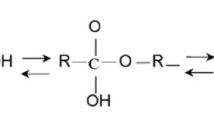Abstract
The dielectric properties of latex water-cast and conventional solvent-cast epoxy neat resin systems were investigated under three formation conditions: solvent-based as-made, water-based as-made, and water-based following a boiling fluid extraction procedure to remove residual surfactant. Samples from each of these three groups were cast, cured, and exposed to controlled humidities in an environmental chamber at room temperature and elevated temperature, a steam bath at various temperatures, and soaked in boiling water. Composite laminates, press fabricated using solvent and latex-based epoxy impregnated glass cloth, were subjected to similar environmental exposure. The microwave frequency dielectric properties of these materials, after each environmental exposure, were measured at 9.4 GHz. These dielectric measurements revealed that under identical exposure conditions, water-borne epoxy systems absorbed more water than solvent-based systems and also allowed more free water into the samples. Extraction of water and soluble components in the resin had no effect on the dielectric properties of the water-borne samples. The presence of high quantities of free water at moisture fractions beyond 4.0 wt %, suggests that the differences between the dielectric properties of solvent and water-borne epoxy systems are due to void morphology, which was confirmed by optical and electron microscopy. ©1999Kluwer Academic Publishers
Similar content being viewed by others
References
J. Shaw, S. Buchwalter, J. Hedrick, S. Kang, L. Kosbar, J. Gelorme, D. Lewis, S. Purushothaman, R. Saraf and A. Viehbeck, Print.Circuit Fabr. 19 (1996) 38.
TECHNotes: Waterbornes, Adhes. Age May (1995) 34.
P. C. Liu, D. Wang, S. Fuerniss, M. Poliks, J. Obrzut, L. Siperko, W. Chen, R. Havens and R. Murcko, Mater Res.Soc.Symp.Proc. 323 (1994) 309.
J. D. Reid, W. H. Lawrence and R. P. Buck, J.Appl.Polym.Sci. 31 (1986) 1771.
A. C. Metaxas and R. J. Meredith, “Industrial Microwave Heating” (Peter, Peregrinus Ltd, London, 1983) p. 39.
R. R. Holmes, “Multilayer Processing”, in Printed Circuits Handbook, 4th Edn, edited by C. F. Coombs, Jr (McGraw-Hill, New York, 1996).
SHELL CHEMICAL COMPANY, “Shell Waterborne Resin Systems for Structural and Industrial Applications”, SC: 2224–96, 1996.
ASTM STANDARD, C 373–88, “Standard Test Method for Water Absorption, Bulk Density, Apparent Porosity, and Apparent Specific Gravity of Fired Whiteware Products”.
ASTM STANDARD D 297–93. “Standard Test Methods for Rubber ProductsÐChemical Analysis”.
M. L. Jackson, “Modeling the Microwave Frequency Permittivity of Thermoplastic Composite Materials”, Master's Thesis: Virginia Polytechnic Institute and State University (1993).
D. Kajfez and E. J. Hwan, IEEE Trans.Microw.Theory Tech. MTT-32 (1984) 666.
H. M. Altschuler, in “Handbook of Microwave Measurements”, 3rd Edn, edited by M. Sucher and J. Fox (Polytechnic Press, New York, 1963) p. 495.
A. W. Scott, “Understanding Microwaves” (John Wiley & Sons Ltd: New York, 1993).
M. G. Mcmaster and D. S. Stone, IEEE Trans.Compon. Hybrids Manuf.Technol. 12 (1989) 373.
Author information
Authors and Affiliations
Rights and permissions
About this article
Cite this article
Jackson, M.L., Love, B.J. & Hebner, S.R. Effects of environmental exposure on solvent- and water-based epoxy systems. Journal of Materials Science: Materials in Electronics 10, 71–79 (1999). https://doi.org/10.1023/A:1008939426270
Issue Date:
DOI: https://doi.org/10.1023/A:1008939426270




